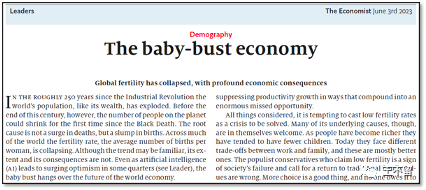The baby-bust economy “婴儿荒”经济 | 经济学人20230603版社论双语精翻
| 阿里云国内75折 回扣 微信号:monov8 |
| 阿里云国际,腾讯云国际,低至75折。AWS 93折 免费开户实名账号 代冲值 优惠多多 微信号:monov8 飞机:@monov6 |
2023年6月3日《经济学人》The Economist封面文章暨社论Leaders精选《“婴儿荒”经济》“The baby-bust economy”。
baby-bust即“婴儿荒”生育低谷与历史上1946~1964年间著名的baby-boom即“婴儿潮”生育高峰相对立。

The baby-bust economy
“婴儿荒”经济
Global fertility has collapsed, with profound economic consequences
全球生育率暴跌带来了深远的经济后果
What might change the world’s dire demographic trajectory?
拿什么来改变这个世界可怕的人口轨迹

In the roughly 250 years since the Industrial Revolution, the world’s population, like its wealth, has exploded. Before the end of this century, however, the number of people on the planet could shrink for the first time since the Black Death. The root cause is not a surge in deaths, but a slump in births. Across much of the world the fertility rate, the average number of births per woman, is collapsing. Although the trend may be familiar, its extent and its consequences are not. Even as artificial intelligence (AI) leads to surging optimism in some quarters, the baby bust hangs over the future of the world economy.
在工业革命后大约250年这段时间里世界人口和财富一样呈爆炸式增长。然而在本世纪末之前地球上的人口数量可能会出现自黑死病Black Death或Black Plague医学称之为bubonic Plague是人类历史上最严重的瘟疫之一。起源于亚洲西南部约在14世纪40年代散布到欧洲。这场瘟疫在全世界造成了大约7500万人死亡其中2500万为欧洲人。根据估计中世纪欧洲约有三分的人口死于黑死病以来的首次减少。其根本原因不是死亡人数激增而是出生人数锐减。在世界大部分地区生育率即每个妇女的平均生育数量正在急剧下降。虽然人们对这一趋势可能已经司空见惯但其程度和后果却并不为人所知。尽管人工智能AI在某些领域引发了高涨的乐观情绪但“婴儿荒”仍笼罩着世界经济的未来。

《经济学人》2023年6月1日文章链接人工智能的繁荣为英伟达带来了巨大的财富。它能守住自己的位置吗?
(https://www.economist.com/leaders/2023/06/01/the-AI-boom-has-turbocharged-nvidias-fortunes-can-it-hold-its-position)
In 2000 the world’s fertility rate was 2.7 births per woman, comfortably above the “replacement rate” of 2.1, at which a population is stable. Today it is 2.3 and falling. The largest 15 countries by GDP all have a fertility rate below the replacement rate. That includes America and much of the rich world, but also China and India, neither of which is rich but which together account for more than a third of the global population.
2000年世界生育率为每名妇女2.7远远高于“替代率/更替率”为2.1的人口稳定值。如今这个数字是2.3而且还在下降。GDP排名前15个国家的生育率都低于更替率。其中包括美国和许多富裕国家也包括中国和印度——这两个国家都不富裕但加起来占全球人口的三分之一以上。

《经济学人》2023年4月26日文章链接为什么印度人口即将超过中国
有史以来第一次中国不再是世界上最大的国家
(https://www.economist.com/the-economist-explains/2023/04/26/why-indias-population-is-about-to-overtake-chinas)
The result is that in much of the world, the patter of tiny feet is being drowned out by the clatter of walking sticks. The prime examples of ageing countries are no longer just Japan and Italy but also include Brazil, Mexico and Thailand. By 2030 more than half the inhabitants of East and South-East Asia will be over 40. As the old die and are not fully replaced, populations are likely to shrink. Outside Africa, the world’s population is forecast to peak in the 2050s and end the century smaller than it is today. Even in Africa, the fertility rate is falling fast.
结果是在世界上很多地方婴儿小脚丫的“啪啪”声被老人拐杖的“咔嗒”声淹没了。老龄化国家的典型例子不再仅仅是日本和意大利还包括巴西、墨西哥和泰国。到2030年东亚和东南亚一半以上人口的年龄将超过40岁。随着老年人的离世并且没有被完全取代低于更替率人口可能会减少。除非洲以外世界人口预计将在本世纪50年代达到峰值到本世纪末人口将比低于目前水平。即使在非洲生育率也在快速下降。

《经济学人》2023年5月25日文章链接日本老龄化社会正在寻找创造性的方式来处理死者——一股新的葬礼策划热潮正在颠覆日本人思考和谈论死亡的方式
(https://www.economist.com/asia/2023/05/25/japans-ageing-society-is-finding-creative-ways-to-dispose-of-its-dead)
Whatever some environmentalists say, a shrinking population creates problems. The world is not close to full and the economic difficulties resulting from fewer young people are many. The obvious one is that it is getting harder to support the world’s pensioners. Retired folk draw on the output of the working-aged, either through the state, which levies taxes on workers to pay public pensions, or by cashing in savings to buy goods and services or because relatives provide care unpaid. But whereas the rich world currently has around three people between 20 and 64 years old for everyone over 65, by 2050 it will have less than two. The implications are higher taxes, later retirements, lower real returns for savers and, possibly, government budget crises.
不管一些环保人士怎么说人口减少会带来问题。世界还没有接近饱和年轻人减少造成的经济困难很多。一个显而易见的问题是养活全世界的养老金领取者正变得越来越困难。退休人员依赖适龄工作者的产出或者通过国家向工作者征税来支付公共养老金或者通过将储蓄兑换成现金来购买商品和服务或者因为亲戚提供无偿照顾。但是目前在富裕国家每一位65岁以上的老人对应3位20岁~64岁的人而到2050年这一比例将不到2位。这意味着更高的税收、更晚的退休年龄、更低的储蓄者实际回报以及可能的政府预算危机。
Low ratios of workers to pensioners are only one problem stemming from collapsing fertility. As we explain this week, younger people have more of what psychologists call “fluid intelligence”, the ability to think creatively so as to solve problems in entirely new ways.
劳动人口与养老金领取者的比例过低只是生育率下降造成的问题之一。正如我们本周所解释的那样年轻人拥有更多心理学家所说的“流动智力”即创造性思维以及用全新方式解决问题的能力。

《经济学人》2023年5月30日文章链接老而无趣——这不仅仅是一场财政惨败老龄化经济体的创新能力正在下降这加剧了劳动力萎缩、医疗保健和养老金账单上涨等问题
(https://www.economist.com/briefing/2023/05/30/its-not-just-a-fiscal-fiasco-greying-economies-also-innovate-less)
This youthful dynamism complements the accumulated knowledge of older workers. It also brings change. Patents filed by the youngest inventors are much more likely to cover breakthrough innovations. Older countries—and, it turns out, their young people—are less enterprising and less comfortable taking risks. Elderly electorates ossify politics, too. Because the old benefit less than the young when economies grow, they have proved less keen on pro-growth policies, especially housebuilding. Creative destruction is likely to be rarer in ageing societies, suppressing productivity growth in ways that compound into an enormous missed opportunity.
这种年轻的活力补充了年长工作者积累的知识。它也带来了变化。最年轻的发明家申请的专利更有可能涵盖突破性的创新。较老的国家——事实证明他们的年轻人更缺乏进取心更不愿意冒险。老年选民也使政治僵化。因为在经济增长时老年人比年轻人受益更少所以他们对促进增长的政策尤其是房屋建设不那么热衷。在老龄化社会中创造性破坏即所谓的“不破不立”现象可能更为罕见这抑制了生产率的增长从而导致巨大的机会错失。
All things considered, it is tempting to cast low fertility rates as a crisis to be solved. Many of its underlying causes, though, are in themselves welcome. As people have become richer they have tended to have fewer children. Today they face different trade-offs between work and family, and these are mostly better ones. The populist conservatives who claim low fertility is a sign of society’s failure and call for a return to traditional family values are wrong. More choice is a good thing, and no one owes it to others to bring up children.
考虑到所有因素很容易将低生育率视为需要解决的危机。然而它的许多潜在原因本身是受欢迎的。随着人们越来越富有他们倾向于少生孩子。如今他们在工作和家庭之间面临着不同的权衡而这些大多是更好的选择。宣称低生育率是社会失败的标志、呼吁回归传统家庭价值观的民粹主义保守派是错误的。更多的选择是一件好事没有人会把抚养孩子归功于别人。
Liberals’ impulse to encourage more immigration is more noble. But it, too, is a misdiagnosis. Immigration in the rich world today is at a record high, helping individual countries tackle worker shortages. But the global nature of the fertility slump means that, by the middle of the century, the world is likely to face a dearth of young educated workers unless something changes.
自由主义者鼓励更多移民的念头更为高尚。但这也是一种误判。如今富裕国家的移民数量创下历史新高帮助各国解决了劳动力短缺问题。但是生育率下降的全球化意味着除非有什么改变否则到本世纪中叶全世界很可能都要面临接受过良好教育的年轻工作者短缺这个问题。

《经济学人》2023年5月28日文章链接出埃及记新一轮大规模移民浪潮已经开始——这对发达经济体意味着什么?
(https://www.economist.com/finance-and-economics/2023/05/28/a-new-wave-of-mass-migration-has-begun)
What might that be? People often tell pollsters they want more children than they have. This gap between aspiration and reality could be in part because would-be parents—who, in effect, subsidise future childless pensioners—cannot afford to have more children, or because of other policy failures, such as housing shortages or inadequate fertility treatment. Yet even if these are fixed, economic development is still likely to lead to a fall in fertility below the replacement rate. Pro-family policies have a disappointing record. Singapore offers lavish grants, tax rebates and child-care subsidies—but has a fertility rate of 1.0.
那会如何人们经常告诉民意调查者他们想要更多的孩子。这种愿望与现实之间存在差距的部分原因可能是作为准父母——他们实际上是在为将来没有孩子的养老金领取者提供补贴——负担不起更多的孩子或者是因为其他政策错误比如住房短缺或产后护理不足。然而即使这些问题得到解决经济发展仍有可能导致生育率下降到更替率以下。崇尚家庭生活和传统道德观的政策记录令人失望。新加坡提供慷慨的补助、退税和儿童保育补贴但生育率仍然只有1.0。
Unleashing the potential of the world’s poor would ease the shortage of educated young workers without more births. Two-thirds of 25- to 34-year-olds in India have not completed upper secondary education. Africa’s pool of young people will continue to grow for decades. Boosting their skills is desirable in itself, and might also cast more young migrants as innovators in otherwise-stagnant economies. Yet encouraging development is hard—and the sooner places get rich, the sooner they get old.
在不增加出生率的情况下释放世界贫困人口的潜力将缓解接受过良好教育年轻工作者短缺的问题。在印度三分之二的25至34岁人口没有完成高中教育。未来几十年非洲的年轻人口将继续增长。提高他们的技能本身是可取的也可能使更多的年轻移民成为创新者以避免经济陷入停滞。然而鼓励发展是困难的——并且一个地方越早富裕起来就会越早进入老龄社会。
Eventually, therefore, the world will have to make do with fewer youngsters—and perhaps with a shrinking population. With that in mind, recent advances in AI could not have come at a better time. An über-productive AI-infused economy might find it easy to support a greater number of retired people. Eventually AI may be able to generate ideas by itself, reducing the need for human intelligence. Combined with robotics, AI may also make caring for the elderly less labour-intensive. Such innovations will certainly be in high demand.
因此最终世界将不得不勉强接受这样一个现状年轻人越来越少——也许总人口也会萎缩。考虑到这一点人工智能最近的进展来得正是时候。一个人工智能驱动的超高生产率经济体可能会发现养活更多的退休人员并非难事。最终人工智能可能会产生自己的想法从而减少对人类智能的需求。与机器人技术相结合人工智能还可能降低照顾老人的劳动密集程度需要更少的劳动力。这样的创新肯定会有很大的需求。
If technology does allow humanity to overcome the baby bust, it will fit the historical pattern. Unexpected productivity advances meant that demographic time-bombs, such as the mass starvation predicted by Thomas Malthus in the 18th century, failed to detonate. Fewer babies means less human genius. But that might be a problem human genius can fix.
如果技术确实能让人类克服生育低谷那是符合历史规律的。意想不到的生产力进步意味着人口定时炸弹——比如托马斯·马尔萨斯托马斯·罗伯特·马尔萨斯牧师Thomas Robert Malthus1766年2月13/14日1834年12月29日英国教士、人口学家、政治经济学家。以其人口理论闻名于世。著有《人口原理》等在18世纪预测的大规模饥荒——未能引爆。更少的婴儿出生意味着更少的天才降临。但是这个问题或许天才可以解决吧。

